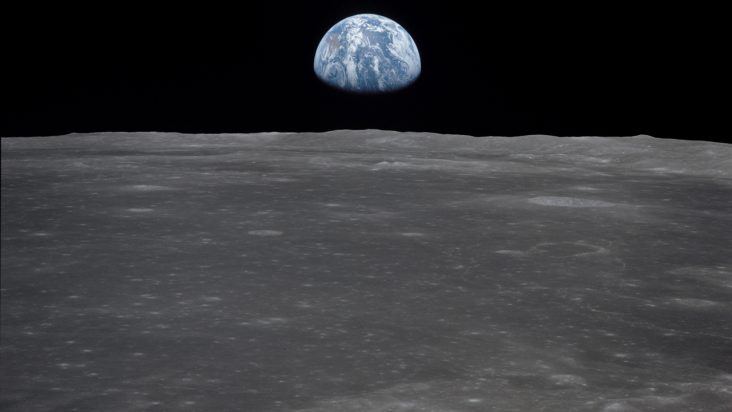Engineers questioned moon shot, but solved problems through clarity, ownership
by October 20, 2019 9:07 am 1,463 views

When President John F. Kennedy proclaimed in May 1961 that the United States would reach the moon by the end of the decade, engineers at first were less than inspired.
“All the engineers that I interviewed thought that was the craziest thing they had ever heard when Kennedy pointed us at the moon,” said Dr. Brandon Brown, a professor of physics and astronomy at the University of San Francisco. “They felt like it was lunacy based on how much we didn’t know we needed to solve.”
Brown discussed his book, “The Apollo Chronicles: Engineering America’s First Moon Missions,” at the Clinton School of Public Service Thursday (Oct. 17).
Kennedy’s exhortation came only 20 days after astronaut Alan Shepard became the first American launched into space. One person told Brown it was the equivalent of asking when a toddler who had just taken his first steps would be ready for a marathon.
Brown was born a few months before the moon landing and is the son of a NASA engineer. Before writing the book, he realized he knew little about his father’s experiences. Books about the moon landing focused mostly on the astronauts, mission control and politics. Engineering-related books were hard to read. So he started interviewing people.
In 1961, the United States was falling behind in the space race. Russia had launched the Sputnik satellite in 1957 and sent cosmonaut Yuri Gagarin into orbit on April 12, 1961. Kennedy’s speech came six weeks later.
But much was not known about space travel at the time. The medical profession wasn’t certain human organs would function properly there. It wasn’t known how much debris existed in space, and whether it would easily puncture a spaceship’s exterior. Could a spaceship’s seams and window sealants survive space? After the landings, astronauts were quarantined for weeks because scientists didn’t know what kind of dormant moon virus they might have acquired.
Just getting into space was a challenge, which the United States overcame with the help of former Nazi scientists like Wernher von Braun. Some of the technology for making the space flight was borrowed. How to transport a rocket loaded with fuel across Florida’s sands was solved thanks to a suggestion by a Kentucky strip mining contractor who overhead the problem being discussed. NASA adapted a crawler with tank treads that accomplished the task.
“Rocketry is at its best a controlled explosion. There’s a tiny separation between disaster and perfect success,” Brown said.
To protect the spacecraft from the sun’s harsh rays, the engineers stood the craft on its side, pointed it toward the North Star and rotated it like a top. The craft would cool as it rotated away from the sun. Engineers called this “barbecue mode.”
Brown said engineers told him the following factors made success possible.
– The clarity of the goal.
– Ownership of the project. Engineers each had their own slice of the mission that they were responsible for delivering. Especially in the early 1960s, there were not levels of people making decisions.
– “Dirty hands management.” Key leaders like von Braun at the Marshall Space Flight Center in Huntsville, Ala., and Dr. Bob Gilruth, who directed NASA’s Manned Spacecraft Center in Houston, would be directly involved in solving technical problems. The engineers who worked for them respected that quality.
– Teamwork. Brown said individuals did not try to stake out their own turfs.
– A lack of bureaucracy, especially in the early 1960s. Despite more than 400,000 Americans and 1,000 or more contracting companies working on the project, it remained nimble and able to solve problems.
NASA’s culture allowed engineers to express misgivings and solve problems, thereby preventing a potential disaster.
“There are just tons of stories of people in their early 20s who were very low in rank ruling the day on a technical issue,” he said.
These lessons came at a cost not only in money but also in lives. Among them were the three astronauts – Roger Chaffee, Ed White, and Gus Grissom – who perished in a fire during a launch rehearsal test in 1967.
“The culture changed pretty dramatically,” he said. “There was this youthful exuberance, and almost, some other authors have called it almost a ‘decoder ring treehouse culture’ that permeated NASA. And a lot of that carefree, ‘smiling all day every day solving these problems’ changed and became a little more grim and serious.”
By the year’s end, astronauts were “flying in new equipment.”
The result of the Apollo effort was more than just beating the Russians to the moon. The space program revolutionized satellite communications. The food industry is now much safer because NASA wasn’t satisfied with the industry’s past practices of waiting for an outbreak of a pathogen to respond. Food poisoning would be disastrous in space. Instead, it would address potential dangers at hazard analysis critical control points. The practice now “informs most of what we eat,” Brown said. Astronauts installed reflectors on the moon’s surface that are still used to measure its distance from the earth with lasers. The moon’s orbit is complicated, and it is slowly receding from the planet.
As for the future, Brown expressed doubts about man’s ability to live on Mars. The Apollo astronauts did experience health effects as a result of their brief travels. Mars has no magnetic field, so he doesn’t believe it would be possible to regrow an atmosphere. Martian soil contains a substance that is hazardous for humans. Keeping the dust out of habitations would be challenging.
“But we have solved more difficult problems before, absolutely,” he said.
